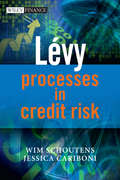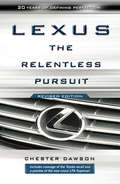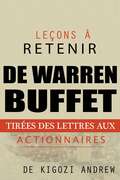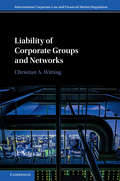- Table View
- List View
Levi Strauss & Co.: Global Sourcing (B)
by Lynn Sharp Paine Jane Palley KatzDescribes the decision taken by Levi Strauss & Co.'s CEO.
Levi Strauss & Co.: Global Sourcing (B)
by Lynn Sharp Paine Jane Palley KatzDescribes the decision taken by Levi Strauss & Co.'s CEO.
Levy Processes in Credit Risk
by Wim Schoutens Jessica CariboniThis book is an introductory guide to using Lévy processes for credit risk modelling. It covers all types of credit derivatives: from the single name vanillas such as Credit Default Swaps (CDSs) right through to structured credit risk products such as Collateralized Debt Obligations (CDOs), Constant Proportion Portfolio Insurances (CPPIs) and Constant Proportion Debt Obligations (CPDOs) as well as new advanced rating models for Asset Backed Securities (ABSs). Jumps and extreme events are crucial stylized features, essential in the modelling of the very volatile credit markets - the recent turmoil in the credit markets has once again illustrated the need for more refined models. Readers will learn how the classical models (driven by Brownian motions and Black-Scholes settings) can be significantly improved by using the more flexible class of Lévy processes. By doing this, extreme event and jumps can be introduced into the models to give more reliable pricing and a better assessment of the risks. The book brings in high-tech financial engineering models for the detailed modelling of credit risk instruments, setting up the theoretical framework behind the application of Lévy Processes to Credit Risk Modelling before moving on to the practical implementation. Complex credit derivatives structures such as CDOs, ABSs, CPPIs, CPDOs are analysed and illustrated with market data.
Lewis Ginter: Richmond's Gilded Age Icon
by Brian BurnsA biography of the nineteenth-century influential Richmond businessman.As a Confederate war hero, philanthropist and entrepreneur, Lewis Ginter was many things to Richmond. Performing integral missions for &“Stonewall&” Jackson and Robert E. Lee, Ginter was commended for gallantry on the battlefield and became affectionately known as the &“Fighting Commissary.&” After the war, Ginter was the first major marketer of the hand-rolled cigarette in America. He developed one of America&’s first streetcar suburbs and built the magnificent Jefferson Hotel, a symbol of Richmond&’s ambition and prosperity. But beyond the well-known history of this River City icon, there are many aspects of his personal and professional life that few know about. Join local writer Brian Burns as he delves into the hidden history of Ginter&’s extraordinary life to fill in the gaps between Ginter the man and Ginter the legend.&“By using many original sources, [Burns] writes of details of Ginter's life that even longtime Richmond-history buffs may not know.&” —Richmond Times-Dispatch
Lewisian Turning Point In The Chinese Economy
by Ryoshin Minami Fumio Makino Kwan S. KimThis volume is concerned with labor market developments in China from a comparative perspective on selected East and South Asian countries. It closely examines the changing structure of China's labor market in the context of the Lewisisan turning point in ecomomic development.
Lex Mercatoria: Essays on International Commercial Law in Honour of Francis Reynolds
by Francis D. RoseThis collection of essays has been written in honour of Francis Reynolds upon his retirement, in recognition of his great service to the law during his distinguished career. They cover the areas in which Francis Reynolds has been most active – English commercial and maritime law in an international context. Topics covered include contract law, the law of agency, carriage of goods by sea, international sale of goods, bankers’ commercial credits and conflict of laws.
Lex Service PLC: Cost of Capital
by W. Carl Kester Kendall BackstrandLex Service company has grown into a large multidivisional company with a substantial capital budget. In 1993, the board was reviewing its capital budgeting procedures. Specifically, it sought to determine the company's cost of capital and whether it should use different hurdle rates for different divisions.
Lexar Media: The Digital Photography Company?
by Mary Tripsas Emily ThompsonExamines growth options for a start-up that has parlayed its core technology in flash memory controllers into a rapidly growing position in the emerging digital photography industry. The new CEO must decide whether LexarMedia should maintain its identity as a digital photography company and pursue market-driven growth by extending its photography presence, or pursue technology-driven growth by applying Lexar's technology in emerging markets such as USB flash drives and MP3 players. Key learnings include: managing new industry creation, managing start-up growth, and the role of firm identity in guiding strategy.
Lexon Corp. (A)
by Lynn Sharp PaineA general manager at Lexon Computer Corp. must decide whether interception and surveillance of employees' e-mail is acceptable company practice, and whether to follow the advice of his computer operations manager who wants to fire the person who complained that the practice violates employees' privacy. The case introduces the topic of employee privacy in the electronic communications environment and potential conflicts between employees' privacy interest and employers' property interests. This case series permits students to compare and contrast the perspectives and modes of reasoning of managers, judges, and policy-makers as they approach the question of employee privacy in the electronic work environment.
Lexoo: Building a Long-Lasting Platform
by Elena Corsi Chiara FarronatoLexoo, a UK-based online marketplace for legal services, was facing the strategic choice of how to grow from early start-up to mature platform. Daniel van Binsbergen, Lexoo's CEO, and web developer Chris O'Sullivan, CTO, had set up Lexoo to help Small and Medium-Sized Enterprises (SMEs) to find legal advice at low prices. At the time of the case in 2018, Lexoo had just started attracting larger companies in need of specialized legal advice as new customers. Larger companies had higher value and more frequent needs. Lexoo could become their "go-to" place across a broad range of legal services. Nevertheless, larger companies also required a more personalized approach and were more difficult to acquire than SMEs. Van Binsbergen and O'Sullivan were debating whether Lexoo should diversify to serve both SMEs and larger companies, or whether to pivot their focus toward larger companies altogether.
Lexoo: Building a Long-Lasting Platform (Abridged)
by Elena Corsi Chiara FarronatoLexoo, a UK-based online marketplace for legal services, was facing the strategic choice of how to grow from early start-up to mature platform. Daniel van Binsbergen, Lexoo's CEO, and web developer Chris O'Sullivan, CTO, had set up Lexoo to help Small and Medium-Sized Enterprises (SMEs) to find legal advice at low prices. At the time of the case in 2018, Lexoo had just started attracting larger companies in need of specialized legal advice as new customers. Larger companies had higher value and more frequent needs. Lexoo could become their "go-to" place across a broad range of legal services. Nevertheless, larger companies also required a more personalized approach and were more difficult to acquire than SMEs. Van Binsbergen and O'Sullivan were debating whether Lexoo should diversify to serve both SMEs and larger companies, or whether to pivot their focus toward larger companies altogether.
Lexus
by Chester C. Dawson IIIA behind-the-scenes look at Lexus's surprising twenty-year success story--in a revised new edition In the 1980s, German brands BMW and Mercedes-Benz dominated the luxury car market and had little reason to fear competition from Japan. But in 1989, Toyota entered the market with the Lexus LS 400, a car that could compete with the Germans in every category but price--it was US$30,000 cheaper. Within two years, Lexus had overtaken Mercedes-Benz in the United States and made a stunning success of Toyota's brave foray into the global luxury market. Lexus: The Relentless Pursuit reveals why Toyota decided to take on the German automakers and how the new brand won praise and success for its unparalleled quality, unforgettable advertising, and unprecedented customer service. From the first boardroom planning session to Lexus's entry into the mega-luxury supercar market, this is the complete and compelling story of one of the world's most admired brands. Includes a new Foreword by legendary designer Erwin Lui, an Afterword with updates since the first edition, and a new Coda by leading Japanese automotive journalist Hisao Inoue Covers the racetrack triumph--and tragedy--behind the new US$375,000 Lexus LFA supercar Offers important business lessons for brand managers and executives For car enthusiasts, business leaders, and anyone interested in branding and marketing, Lexus: The Relentless Pursuit offers an amazing story of excellence and innovation in the automotive industry.
Lezioni di imprenditoria da Bill Gates
by Stefano Vazzola Michael WinicottBill Gates è un'icona del mondo moderno. È d'ispirazione per i giovani e un monito per gli anziani. Ha raggiunto vette di successo e gloria che solo pochi sono riusciti a ottenere nelle loro vite. Vale davvero la pena leggere e imparare dalla storia della sua vita. Lezioni di imprenditoria da Bill Gates è un'opera che vi illustrerà la storia della vita di Bill Gates da una prospettiva diversa: le lezioni che ha imparato nella vita. Lezioni di imprenditoria da Bill Gates vi farà proseguire trepidanti nel racconto e resterà con voi anche dopo avere concluso la lettura. Vi renderà persone migliori mentre imparate passo dopo passo gli insegnamenti della vita di Bill Gates. Quando vi troverete di fronte a un problema simile nella vostra vita, saprete come farvi fronte e superare ciò che sembrava un ostacolo insormontabile. Allora siete pronti a imparare dalla vita di Bill Gates? Vi interessa apprendere nozioni commerciali e di imprenditoria? E anche più importante, siete pronti a imparare qualcosa sulla vita? Immergetevi nella lettura di Lezioni di imprenditoria da Bill Gates e iniziate subito a imparare!
Leçons à retenir des lettres aux actionnaires de Warren Buffet
by Laure Valentin Kigozi AndrewCet ouvrage éducatif présente plusieurs leçons tirées des lettres de Warren Buffet à ses actionnaires. Les leçons de ce livre concernent tous les types d'investisseurs, les étudiants en commerce de tous niveaux, les responsables de société ainsi que toutes les personnes intéressées par le sujet. Les leçons reprennent les conseils de Warren sur l'investissement (les titres et valeurs), les affaires et l'organisation idéale d'une société (sa structure). Si vous cherchez un résumé de tous les conseils en investissement pleins de sagesse que Warren Buffet a écrits pour ses actionnaires au fil des ans, ce livre est fait pour vous. Si vous cherchez un rapide aperçu instructif, ce livre est fait pour vous. J'espère que cet ouvrage vous donnera un meilleur point de vue sur l'investissement d'excellence et la gestion d'entreprise.
Li & Fung (A): Beyond
by Michael Y. Yoshino Anthony St. GeorgeIn early 1998, William and Victor Fung had to review their business, the Li & Fung Group, to plan for the next three years. Examines strategic and organizational issues including company culture, international expansion, and venture capital projects. A rewritten version of an earlier case.
Li & Fung (Trading) Ltd.
by Gary W. Loveman Jamie O'ConnellLi & Fung, one of the largest export trading companies in Asia, works primarily as an agent to connect U.S. and European manufacturers and retailers of nondurable, mass-market consumer goods with suppliers located all over East Asia who manufacture products according customer designs. Li & Fung's network of 2,000 suppliers in over a dozen countries is one of its most important competitive assets. This network consists of relationships with suppliers and knowledge of their capabilities and strengths. The network provides a number of benefits to customers, the most important being a wide variety of manufacturing options that differ by price, quality, and delivery time. Li & Fung's trading operations are organized into largely-independent, customer-focused divisions aided by regional branch offices. Its internal structure and incentives (especially compensation) are designed to motivate staff to customize service to each customer and to use the entire network to place each customer order with the supplier that most closely fits customer requirements. This design is especially important because of trading's low margins.
Li & Fung 2006
by William C. Kirby F. Warren Mcfarlan Tracy Yuen MantyDescribes the opportunities and strategy facing one of the most innovative global supply-chain companies, and the strategy it has chosen to deal with the expanding demand for its services. Li & Fung links thousands of factories in India, China, and elsewhere to nearly a thousand large retailers, primarily in the U.S. and Europe. It basically does the supply-chain job faster and more accurately with the aid of a sophisticated information system than anyone else.
Li & Fung 2012
by F. Warren Mcfarlan Michael Shih-ta Chen Keith Chi-ho WongMidway through its current three-year plan, Li & Fung stop to assess the path it is taking in extending its distribution network business in Asia.
Li Ka-Shing and the Growth of Cheung Kong
by Nitin Nohria Anthony J. Mayo Mark BensonEvents in the history of Cheung Kong's growth reveal how Li Ka-Shing applied his skills as a "first-class noticer" to complex political and socioeconomic environments. While Li's determination to succeed is legendary, so are his skills in reading and responding to the policies and norms of the People's Republic of China, British colonial Hong Kong, and the post-World War II international system. Since Li became the taipan of Hutchison Whampoa in the late 1970s, he has adjusted his ownership shares in a vast portfolio of businesses-including ports, energy, real estate, retail, telecommunications, and new media. Illustrates how Li applied his business acumen and his ability as a first-class noticer to decisions about raising or lowering his stake in these businesses, and whether to acquire new ones. After starting Cheung Kong Inc. in 1950, at age 21, Li built upon his knowledge and contacts in the plastics industry to become Hong Kong's King of Plastic Flowers. In the 1960s, amid political turmoil and labor unrest on both the mainland and in colonial Hong Kong, Li purchased rights to properties on Hong Kong island that were selling at distressed rates. Li's successes in industry and real estate continued, and he cultivated contacts and built a strong reputation that set the stage for his purchase of the hong Hutchinson Whampoa, thereby becoming the first Chinese taipan. As taipan, Li reorganized and reallocated his various financial holdings in the 1980s and 1990s as conditions were in flux due to the Westernization of China after Deng Xiaoping succeeded Mao Zedong, and amid concerns about the transfer of Hong Kong from Britain back to China in 1997.
Li Ning--Anything is Possible
by Luc WathieuA leading sporting goods company in China competes aggressively against global brands Nike and Adidas, with marketing strategies adapted to geographic segments. In the main cities, where competition takes place at a very conceptual level, Li Ning has chosen to adopt a very controversial "oriental theme" for its brand, while becoming at the same time a major sponsor of international athletes of the highest caliber.
Liabilities and Time
by William J. Bruns Jr.An introduction to accounting for liabilities. Both current liabilities and long-term debts are described, and illustrations of bond interest calculations and financial reporting formats are included.
Liability Management at General Motors
by Peter TufanoAn analyst at General Motors charged with managing the structure of the automaker's debt must decide whether and how to modify the interest rate exposure of the firm's most recent debt offering. The analyst must take into consideration GM's liability management policy guidelines, the firm's existing interest rate exposure, his expectations of interest rates, and the wide range of interest rate products available. He must decide whether to leave the fixed-rate instrument unchanged or to enter into a swap, cap, interest rate option, or swap option transaction.
Liability Reporting
by Paul M. Healy Preeti ChoudharyBy examining key criteria for recognizing a liability, this case explores liability recognition in straightforward situations and then examines the most difficult reporting issues in recording liabilities. These often arise when: 1) uncertainty arises about whether an obligation has been incurred; or 2) measuring the value of the obligation is difficult.
Liability of Corporate Groups and Networks (International Corporate Law and Financial Market Regulation)
by Christian A. WittingWhat happens when a corporate subsidiary or network company is unable to pay personal injury victims in full? This book sets out to tackle the 'insolvent entity problem', especially as it arises in cases of mass wrongdoing such as those involving asbestos exposure and defective pharmaceuticals. After discussing the nature of corporate groups and networks from the perspectives of business history, organisation studies, and social theory, the book assesses a range of rules and proposed rules for extending liability for personal injuries beyond insolvent entities. New proposals are put for an exception to the rule of limited liability and for the development of a flexible new tort based on conspiracy that encompasses not only control-based relationships but also horizontal coordination between companies. The book concludes with a general discussion of lessons learned from debates about extended liability and provides guidelines for the development of new liability rules. Features a detailed proposal for the development of a statutory exception to limited liability applicable in cases of personal injury. Proposes development of the common law of conspiracy so as to create a new remedy where companies are in commercial agreements with another which is engaged in objectively reckless conduct. Assesses the law on group and network liability in leading common law jurisdictions to provide a better understanding of what gives corporate groups and networks their cohesion and why the law should be prepared to extend liability beyond the insolvent entity.








